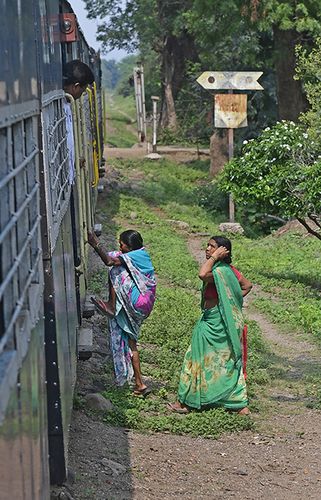 A villager, on bike, hands over money to his friend on the train.
A villager, on bike, hands over money to his friend on the train.
As the American author Marianne Williamson said, “It is not your train if it doesn’t stop at your station.” But the Shakuntala Express stops, whenever you want it and wherever you want it. And, it has been doing so for the last 114 years, plying between Achalpur and Murtizapur in the Vidarbha region of Maharashtra. The only functional narrow gauge passenger train in India, it is the most loved mode of transport for people in Amravati and Akola districts, and is inexpensive. That is precisely why it is a ‘people’s train’. “The Shakuntala Express is a grand heritage, something we should cherish and preserve,” said Vijay Wilhekar aka Vijubhau, a farmer activist. “It is the most economical option for poor farmers and farm labourers.”
The three-coach train with a steam engine was built and owned by Killick Nixon, a British company. R.K. Yadav, divisional railway manager, Bhusawal division, said the narrow gauge line is still owned by the British company, and talks are on about its transfer to the Indian Railways. The steam engine was replaced with a diesel one in 1994. The two-foot-wide track was laid in 1903 to connect the cotton producing regions to the broad gauge line at Murtizapur junction. Cotton from Vidarbha was thus transported to the port in Mumbai to be exported to Manchester. “Although the train was started for transporting cotton, it soon became popular as the villagers needed to travel to towns for various tehsil and court matters,” said Wilhekar. Even today, daily wage labourers from Melghat take the train to go looking for jobs at nearby villages and towns.
There is a trainload of nuggets about the Shakuntala Express. It is probably the only train in India that is named after a common citizen. In 1944, Shakuntala Jadhav, 16, got married to a Daryapur landlord, Balawantrao Deshmukh, who was also a freedom fighter. The groom’s family, taking the newly-weds home, boarded the train from Murtizapur. A British railway officer offered them the first class coach. “It was a dream come true for the bride,” said Shakuntala’s daughter Lalita Deshmukh, a retired school principal. “The train lost its glory after independence as it was not owned by the Indian Railways. My mother described the entire experience of her journey to Sudam Deshmukh, who was an MP. Thrilled, he helped revive its glory and also named it Shakuntala Express.”
 The train halts to pick up passengers in between stations.
The train halts to pick up passengers in between stations.
The Achalpur station, with a tiled roof, has an old ticket counter on one side and a computerised ticketing centre on the other (a one-way ticket costs Rs 20). I found the platform almost deserted, with just two persons waiting for the train to arrive—a kind of culture shock to the Mumbai commuter that I am. Around noon, the train rolled in majestically, blowing its horn long before it reached the platform. It was more than an hour late, as the train takes its own sweet time, halting for passengers in between stations. More than ten passengers boarded the train from Achalpur, though each coach could seat 50 passengers. One of them, Laxman Solanki, a 70-year-old farmer from Chamak village, was returning home after buying vegetables at the weekly bazaar in Achalpur. “Every week I take this train to come to the bazaar,” he said. “It has been my routine for the last 60 years.”
It was a hot day, and the dysfunctional fans in the train made it worse. “The speed of this train is 20km/hr, and it is so slow that the batteries to operate lights and fans in the coaches do not get sufficiently charged. Only a few lights work,” said Ashish Wankhede, a mobile gateman. Gatemen are stationed at the level crossings on other lines, and the Shakuntala Express is the only train that has a gateman on board. The mobile gateman alights before every level crossing to close the gate, and opens it once the train passes. The train halts a few metres after the crossing, for him to board it again. “I have to manage eight of 64 crossings on the way. The rest are mud roads where only bullock carts pass, and the farmers manage those crossings,” said Wankhede, who also doubles as a ticketing clerk, helping the guard issue tickets to passengers who board midway through the 76km journey. The guardroom, apart from a table and a seat for the two, has a wooden cupboard, with small boxes, containing tickets for each station, stacked in vertical columns.
But, the Shakuntala Express’s slow run could come to an end. Last year, the government sanctioned Rs 1,500 crore to convert the line to broad gauge. But Wilhekar is against it. “We should learn to preserve such heritage,” he said. “The grand iron bridges across the Chandrabhaga and Sapan rivers, built during the British Raj, are majestic structures.” Widening the rail lines could lead to the demolition of the bridges.
A journey on the Shakuntala Express had been on my bucket list for long, and, like always, the camera was my companion. Capturing the 114-year-old iron lady on track felt like documenting it for posterity.







